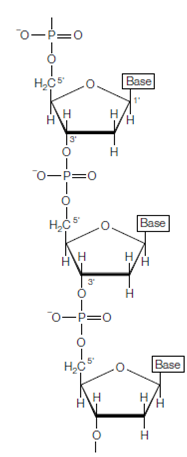3′5′ phospho-diester bonds:
In a DNA molecule the various nucleotides are covalently joined to form a long polymer chain through covalent bonding among the phosphates and sugars. For the any one nucleotide phosphate attached to the hydroxyl group at the 5' position of the sugar is in turn bonded to the hydroxyl set on the 3' carbon of the sugar of the next nucleotide. Because every phosphate-hydroxyl bond is an ester bond, the linkage among the two deoxynucleotides is a 3'5' phosphodiester bond. Therefore, in a DNA chain, all of the 3' and 5' hydroxyl groups are included in phosphodiester bonds except for the first and the last nucleotide in the chain. The 1st nucleotide has a 5' phosphate not bonded to any other nucleotide and the last nucleotide has a free 3' hydroxyl. Therefore every DNA chain has polarity; it has a 5' end and a 3' end.

figure: 3′5′ phosphodiester bonds formed between nucleotides in a DNA molecule.
DNA sequence:
Each nucleotide can be thought of as a single letter in an alphabet which has only four letters, A, G, C and T. Different genes have various sequences of these four nucleotides and so code for different biological messages. Because the deoxynucleotides in DNA differ only in the bases they hold, this sequence of deoxynucleotides can be recorded simply as a base sequence. For instance, ACTTTCAGACC is part of the base sequence of one gene and codes for component of one protein while TGGAACCGTCA is components of the base sequence of a several gene coding for a different protein. Usually the base sequence is written in the order from the 5' end of the DNA strand to the 3' end, instance example. it is written in the 5'→3' direction. Given that there are four kinds of nucleotide the number of various possible sequences or messages in a DNA strand n nucleotides long is 4n. DNA molecules are typically several thousands of nucleotides long so which the number of possible messages is enormous.